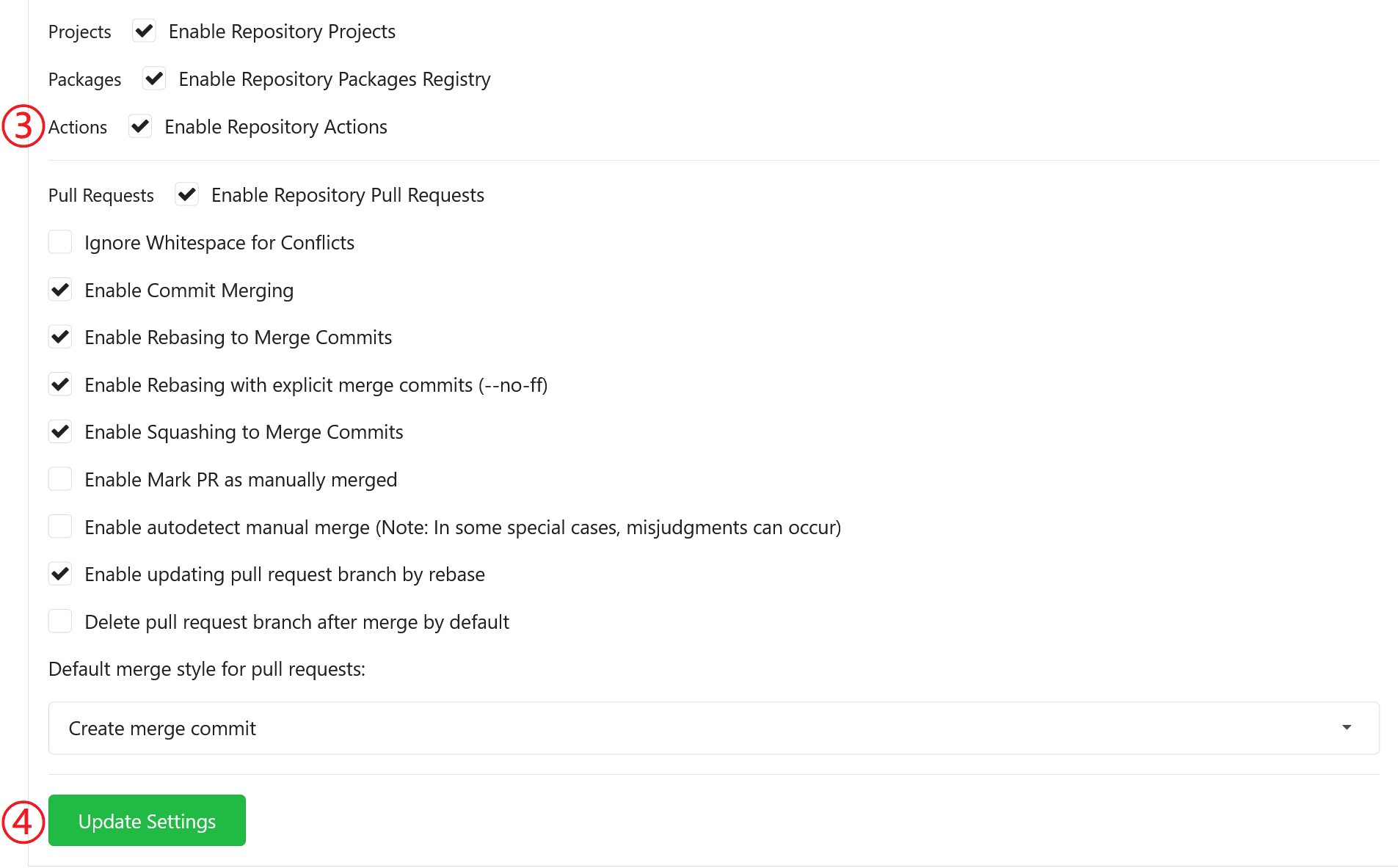Feature Preview: Gitea Actions
One of the most requested features of Gitea is inclusion of a CI/CD system, and better integration with existing third-party CI/CD systems. With the work being done on Gitea Actions, we hope to provide a solution to this problem.
❗ Disclaimer
⚠️ the feature is EXPERIMENTAL, and please note that:
- It is disabled by default;
- It shouldn't be used in a production environment currently;
- It shouldn't be used in a public Gitea instance currently;
- Breaking changes may be made before it's stable.
- The pull request is being reviewed by the community and changes may be made to the design.
Overview of Gitea Actions
The aim of Gitea actions is to bring closer integration between Gitea and existing CI/CD systems. Another goal is to expose a unified management inteface for standalone runners to reduce the adminstrative overhead of supporting multiple systems if desired. The standalone runner workflows are designed to be compatible with GitHub Actions, and can be used to build, test, package, release, or deploy any code project on Gitea.
Gitea Actions goes beyond just DevOps and lets you run workflows when other events happen in your repository. For example, you can run a workflow to automatically add the appropriate labels whenever someone creates a new issue in your repository.
DevOps Toolchains
There are many third-party CI/CD systems that can be integrated with Gitea. Here are some of the most popular ones:
- Agola
- AppVeyor
- AWS Cloud Integration(webhook-to-s3)
- buildbot-gitea
- buildkite-connector
- Concourse
- Dex
- Drone
- Jenkins
- Jianmu CI
- Metroline
- mvoCI
- Tea Runner
- Woodpecker
The new Gitea Actions system would allow these existing systems to push their results directly into Gitea, allowing them to be viewed in a unified way, and should a administrator wish not to have to manage multiple systems, they can be use the option of standalone runners.
Create Gitea Actions
The design concept of keeping the workflow included in the repository (such as how Drone, Woodpecker, and GitHub Actions do) enables tighter integration between repository and CI tools, realizing configuration as code. At the same time, platform users provide rich application extensions for the entire system.
After two years of research and discussion, development task of Gitea's built-in CI/CD system has made significant progress. (Join the discussion #13539)
Implement
Gitea Actions implements a built-in CI/CD system framework, compatible with GitHub Actions' YAML workflow format, and compatible with most existing Actions plugins in GitHub Marketplace.
The system has three parts:
- Definition and implementation of Gitea Actions Protocol. Third party CI/CD systems could use this protocol to publish their results directly into Gitea.
- A runner for Gitea based on nektos/act.
- Implementation Actions management subsystem
Screenshots
1.System administrators can access the Runners management interface to create, edit, and delete Runners.

2.Open Actions from the navigation bar to view the CI build log.

3.View logs.

Try it on local machine
Requirement
- All the existing required tools to build Gitea
- Docker: Callable docker API for running containers
Build from source
1.Start Gitea
Clone the feature branch and install from source:
git clone https://github.com/go-gitea/gitea.git
cd gitea
git fetch origin pull/21937/head
git checkout -b pullrequest FETCH_HEAD
# Build with SQLite support
TAGS="bindata sqlite sqlite_unlock_notify" make build
# Initialize Gitea
./gitea web
Add additional configurations in app.ini to enable Actions:
# custom/conf/app.ini
[actions]
ENABLED = true
Restart it. If all is well, you'll see the Runner Management page in Site Administration.
2.Start runner
Clone the act_runner, and follow the README to start it.
git clone https://gitea.com/gitea/act_runner.git
cd act_runner
make build
Then register the Runner to the Gitea server.
Interactive commands:
./act_runner register
And you will be asked to input:
- Gitea instance URL, like
http://192.168.1.100:3000/. You should use your gitea instance ROOT_URL as the instance argument and you should not use localhost or 127.0.0.1 as instance IP; - Runner token, you can get it from
http://192.168.1.100:3000/admin/runners; - Runner name, you can just leave it blank;
- Runner labels, you can just leave it blank.
No-interactive commands:
./act_runner register --instance http://<your_gitea_instance> --token <your_runner_token> --no-interactive
Run as daemon
./act_runner daemon
3.Enable actions for a repo
Create a new repo or open an existing one, check the Actions checkbox in settings and submit.


If all is well, you'll see a new tab "Actions":

4.Upload workflow files
Upload some workflow files to .gitea/workflows/<some-actions-name>.yaml, you can follow the quickstart of GitHub Actions. Yes, Gitea Actions is compatible with GitHub Actions in most cases, you can use the same demo:
# .gitea/workflows/build.yaml
name: Gitea Actions Demo
run-name: ${{ github.actor }} is testing out Gitea Actions 🚀
on: [push]
jobs:
Explore-Gitea-Actions:
runs-on: ubuntu-latest
steps:
- run: echo "🎉 The job was automatically triggered by a ${{ github.event_name }} event."
- run: echo "🐧 This job is now running on a ${{ runner.os }} server hosted by Gitea!"
- run: echo "🔎 The name of your branch is ${{ github.ref }} and your repository is ${{ github.repository }}."
- name: Check out repository code
uses: actions/checkout@v3
- run: echo "💡 The ${{ github.repository }} repository has been cloned to the runner."
- run: echo "🖥️ The workflow is now ready to test your code on the runner."
- name: List files in the repository
run: |
ls ${{ github.workspace }}
- run: echo "🍏 This job's status is ${{ job.status }}."
If all is well, you'll see a new run in Actions tab:

5.Check the logs of jobs
Click a run and you'll see the logs. It is easy to see that Gitea Runner has pulled the Docker image as the basic environment

- Future Exploration
With the overlap between Gitea Actions and GitHub actions, you can try some examples in the documention of GitHub Actions, and if you find bugs please report them so they can be resolved.